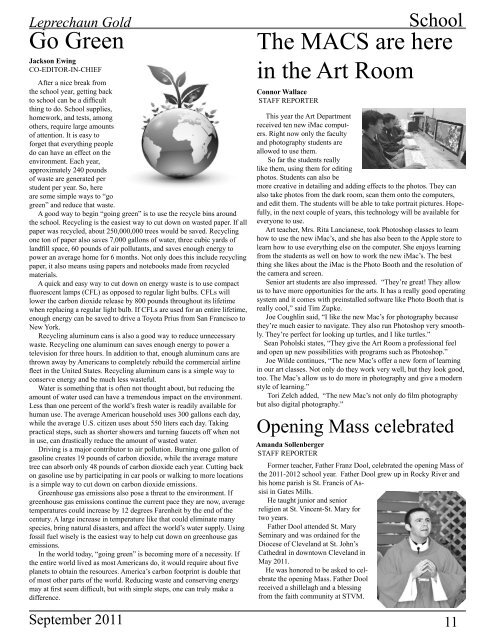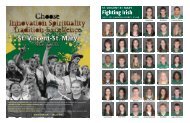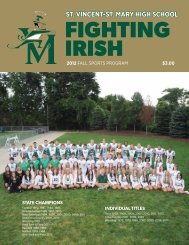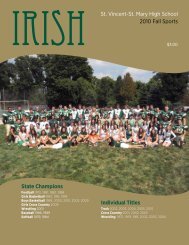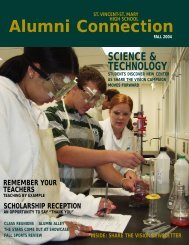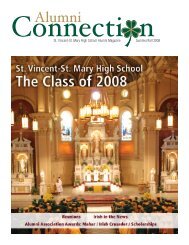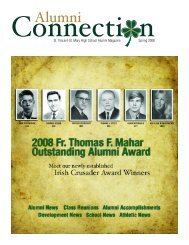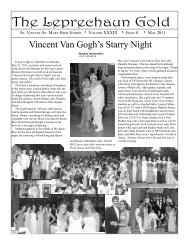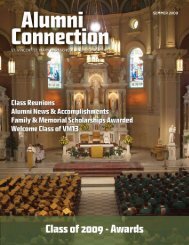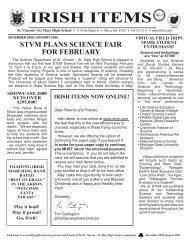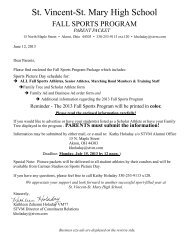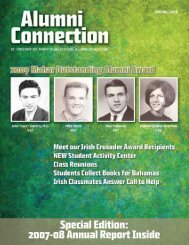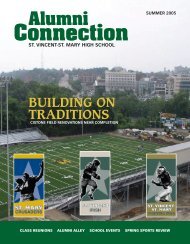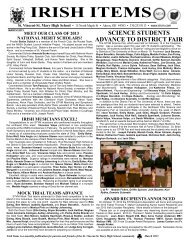The Leprechaun Gold - St. Vincent-St. Mary High School
The Leprechaun Gold - St. Vincent-St. Mary High School
The Leprechaun Gold - St. Vincent-St. Mary High School
You also want an ePaper? Increase the reach of your titles
YUMPU automatically turns print PDFs into web optimized ePapers that Google loves.
<strong>Leprechaun</strong> <strong>Gold</strong><br />
Go Green<br />
Jackson Ewing<br />
Co-Editor-in-chief<br />
After a nice break from<br />
the school year, getting back<br />
to school can be a difficult<br />
thing to do. <strong>School</strong> supplies,<br />
homework, and tests, among<br />
others, require large amounts<br />
of attention. It is easy to<br />
forget that everything people<br />
do can have an effect on the<br />
environment. Each year,<br />
approximately 240 pounds<br />
of waste are generated per<br />
student per year. So, here<br />
are some simple ways to “go<br />
green” and reduce that waste.<br />
A good way to begin “going green” is to use the recycle bins around<br />
the school. Recycling is the easiest way to cut down on wasted paper. If all<br />
paper was recycled, about 250,000,000 trees would be saved. Recycling<br />
one ton of paper also saves 7,000 gallons of water, three cubic yards of<br />
landfill space, 60 pounds of air pollutants, and saves enough energy to<br />
power an average home for 6 months. Not only does this include recycling<br />
paper, it also means using papers and notebooks made from recycled<br />
materials.<br />
A quick and easy way to cut down on energy waste is to use compact<br />
fluorescent lamps (CFL) as opposed to regular light bulbs. CFLs will<br />
lower the carbon dioxide release by 800 pounds throughout its lifetime<br />
when replacing a regular light bulb. If CFLs are used for an entire lifetime,<br />
enough energy can be saved to drive a Toyota Prius from San Francisco to<br />
New York.<br />
Recycling aluminum cans is also a good way to reduce unnecessary<br />
waste. Recycling one aluminum can saves enough energy to power a<br />
television for three hours. In addition to that, enough aluminum cans are<br />
thrown away by Americans to completely rebuild the commercial airline<br />
fleet in the United <strong>St</strong>ates. Recycling aluminum cans is a simple way to<br />
conserve energy and be much less wasteful.<br />
Water is something that is often not thought about, but reducing the<br />
amount of water used can have a tremendous impact on the environment.<br />
Less than one percent of the world’s fresh water is readily available for<br />
human use. <strong>The</strong> average American household uses 300 gallons each day,<br />
while the average U.S. citizen uses about 550 liters each day. Taking<br />
practical steps, such as shorter showers and turning faucets off when not<br />
in use, can drastically reduce the amount of wasted water.<br />
Driving is a major contributor to air pollution. Burning one gallon of<br />
gasoline creates 19 pounds of carbon dioxide, while the average mature<br />
tree can absorb only 48 pounds of carbon dioxide each year. Cutting back<br />
on gasoline use by participating in car pools or walking to more locations<br />
is a simple way to cut down on carbon dioxide emissions.<br />
Greenhouse gas emissions also pose a threat to the environment. If<br />
greenhouse gas emissions continue the current pace they are now, average<br />
temperatures could increase by 12 degrees Farenheit by the end of the<br />
century. A large increase in temperature like that could eliminate many<br />
species, bring natural disasters, and affect the world’s water supply. Using<br />
fossil fuel wisely is the easiest way to help cut down on greenhouse gas<br />
emissions.<br />
In the world today, “going green” is becoming more of a necessity. If<br />
the entire world lived as most Americans do, it would require about five<br />
planets to obtain the resources. America’s carbon footprint is double that<br />
of most other parts of the world. Reducing waste and conserving energy<br />
may at first seem difficult, but with simple steps, one can truly make a<br />
difference.<br />
September 2011<br />
<strong>School</strong><br />
<strong>The</strong> MACS are here<br />
in the Art Room<br />
Connor Wallace<br />
STAFF REPORTER<br />
This year the Art Department<br />
received ten new iMac computers.<br />
Right now only the faculty<br />
and photography students are<br />
allowed to use them.<br />
So far the students really<br />
like them, using them for editing<br />
photos. <strong>St</strong>udents can also be<br />
more creative in detailing and adding effects to the photos. <strong>The</strong>y can<br />
also take photos from the dark room, scan them onto the computers,<br />
and edit them. <strong>The</strong> students will be able to take portrait pictures. Hopefully,<br />
in the next couple of years, this technology will be available for<br />
everyone to use.<br />
Art teacher, Mrs. Rita Lancianese, took Photoshop classes to learn<br />
how to use the new iMac’s, and she has also been to the Apple store to<br />
learn how to use everything else on the computer. She enjoys learning<br />
from the students as well on how to work the new iMac’s. <strong>The</strong> best<br />
thing she likes about the iMac is the Photo Booth and the resolution of<br />
the camera and screen.<br />
Senior art students are also impressed. “<strong>The</strong>y’re great! <strong>The</strong>y allow<br />
us to have more opportunities for the arts. It has a really good operating<br />
system and it comes with preinstalled software like Photo Booth that is<br />
really cool,” said Tim Zupke.<br />
Joe Coughlin said, “I like the new Mac’s for photography because<br />
they’re much easier to navigate. <strong>The</strong>y also run Photoshop very smoothly.<br />
<strong>The</strong>y’re perfect for looking up turtles, and I like turtles.”<br />
Sean Poholski states, “<strong>The</strong>y give the Art Room a professional feel<br />
and open up new possibilities with programs such as Photoshop.”<br />
Joe Wilde continues, “<strong>The</strong> new Mac’s offer a new form of learning<br />
in our art classes. Not only do they work very well, but they look good,<br />
too. <strong>The</strong> Mac’s allow us to do more in photography and give a modern<br />
style of learning.”<br />
Tori Zelch added, “<strong>The</strong> new Mac’s not only do film photography<br />
but also digital photography.”<br />
Opening Mass celebrated<br />
Amanda Sollenberger<br />
STAFF REPORTER<br />
Former teacher, Father Franz Dool, celebrated the opening Mass of<br />
the 2011-2012 school year. Father Dool grew up in Rocky River and<br />
his home parish is <strong>St</strong>. Francis of Assisi<br />
in Gates Mills.<br />
He taught junior and senior<br />
religion at <strong>St</strong>. <strong>Vincent</strong>-<strong>St</strong>. <strong>Mary</strong> for<br />
two years.<br />
Father Dool attended <strong>St</strong>. <strong>Mary</strong><br />
Seminary and was ordained for the<br />
Diocese of Cleveland at <strong>St</strong>. John’s<br />
Cathedral in downtown Cleveland in<br />
May 2011.<br />
He was honored to be asked to celebrate<br />
the opening Mass. Father Dool<br />
received a shillelagh and a blessing<br />
from the faith community at STVM.<br />
11


